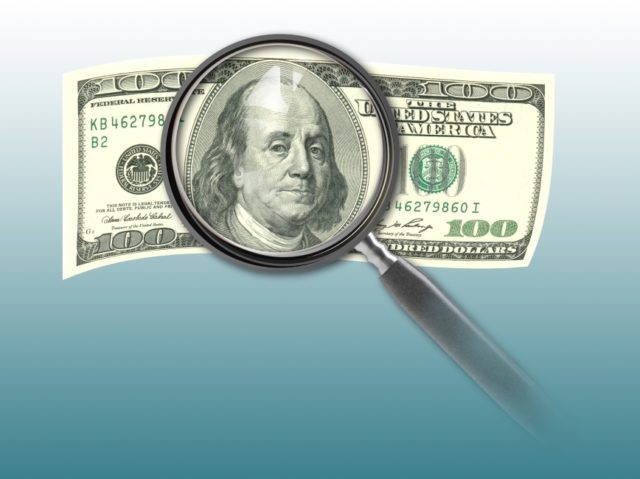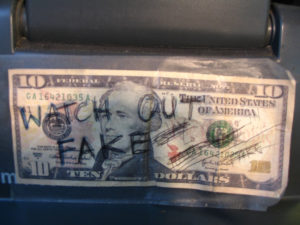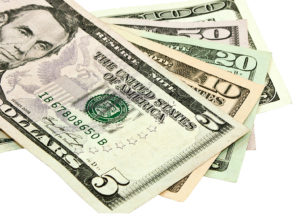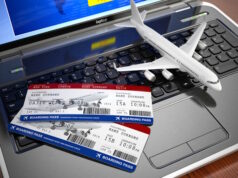
With so many cyber-attacks and identity theft cases we hear about, it’s easy to forget that there is another real financial threat that could impact your business and bottom line – counterfeit currency.
Although most people use credit or debit cards today, phony money is thriving and moving from business to business. In fact, there is approximately one fake bill in every 10,000 U.S. notes, which equals $147 million in counterfeit money in circulation, according to the U.S. Treasury Department.
“Any bills from $5 to $100 can be forged,” said Trevor Buxton, certified fraud examiner at PNC Bank.
“The $20 bill is far and away the most frequently counterfeited. Since fraudsters are investing so much time and money to do this, they want to make the most significant profit. Fraudulent notes larger than $20 are more obvious, and smaller ones are hardly worth the effort.”
According to Buxton, criminals don’t bother with the $1 bill, which is probably why it lacks the security features present on the $5 to $100 notes, and larger bills just don’t exist. U.S. bills over $100 were pulled from distribution in 1969 by the Federal Reserve due to lack of use.
The most prevalent places where counterfeit money is laundered are cash-intensive businesses like nightclubs, bars and adult entertainment. The theory is it’s easier to substitute bogus bills for legitimate money at these types of businesses.

Getting Around the Pen Test
Most businesses use the all-familiar counterfeit pen checker to alert the cashier that they’re in possession of a fake bill. Unfortunately, the pens aren’t as reliable as they used to be. To beat the criminals at their own game, businesses may want to upgrade to UV lights, which quickly show the appropriate color shift on authentic U.S. notes.
“Even with all the advanced components on the U.S. bill, criminals have become much more technically-savvy. Counterfeiters have added many of the same chemicals to the ink and images on the fake notes that are used in legitimate bills, which fools the pen test and passes the bill as authentic,” said Buxton.
Criminal Techniques are More Sophisticated
In September, Alabama police sent a warning to Dothan merchants: “We’re seeing a growing number of counterfeit bills circulating, mostly $20 and $100, so we need people to be extra vigilant in checking the authenticity of money that’s used at their business.”
However, this problem isn’t only found in Alabama. There have been recent reported arrests in Providence, Charleston, Baltimore, Miami and Orlando.
“These scam artists might send an elderly woman or someone in a suit and tie to pass the bogus bills to receive less scrutiny. It’s essential that the cashier focus on the notes and not the person,” Buxton added.
The U.S. Currency Education Program advises that business owners should look for:
- Texture and thickness – U.S. bills are finer and thinner than fake money
- Security thread that is embedded inside the bill – position varies
- A watermark that matches the portrait, except for Abraham Lincoln on the $5
- Color shifting ink used on $10 – the numeral on the bottom right should change from copper to green
Location and colors of the security threads on U.S. bills:
- $5 – Right side, glows blue under UV light
- $10 – Right side, glows orange under UV light
- $20 – Far left hand side, glows green under UV light
- $50 – Right around the middle, glows yellow Under UV light
- $100 – On left side, glows pink under UV light
Business owners can also download free materials about U.S. currency in 24 languages from the U.S. Currency Education Program.
Source: PNC Bank
These articles are for general information purposes only and are not intended to provide legal, tax, accounting or financial advice. PNC urges its customers to do independent research and to consult with financial and legal professionals before making any financial decisions.
This site may provide reference to Internet sites as a convenience to our readers. While PNC endeavors to provide resources that are reputable and safe, we cannot be held responsible for the information, products or services obtained on such sites and will not be liable for any damages arising from your access to such sites. The content, accuracy, opinions expressed and links provided by these resources are not investigated, verified, monitored or endorsed by PNC.













